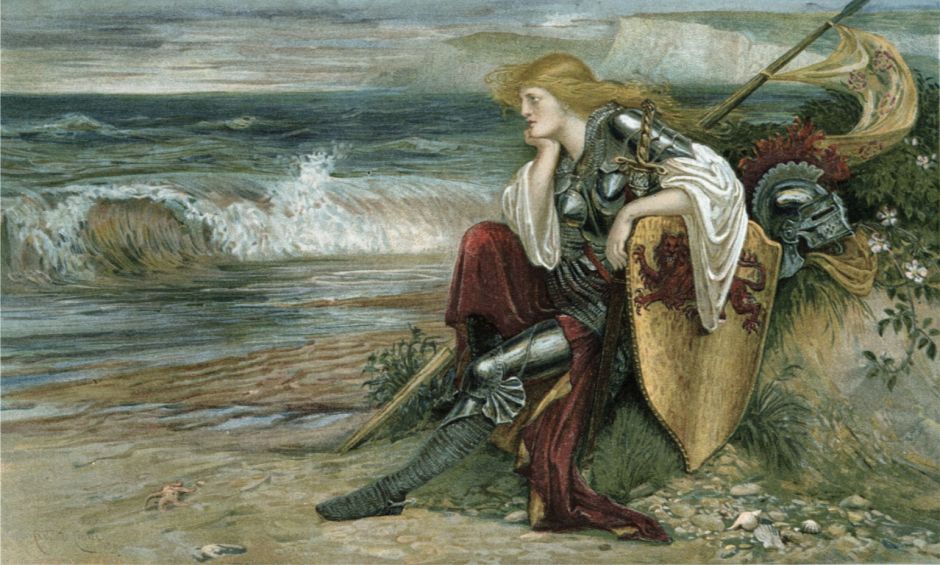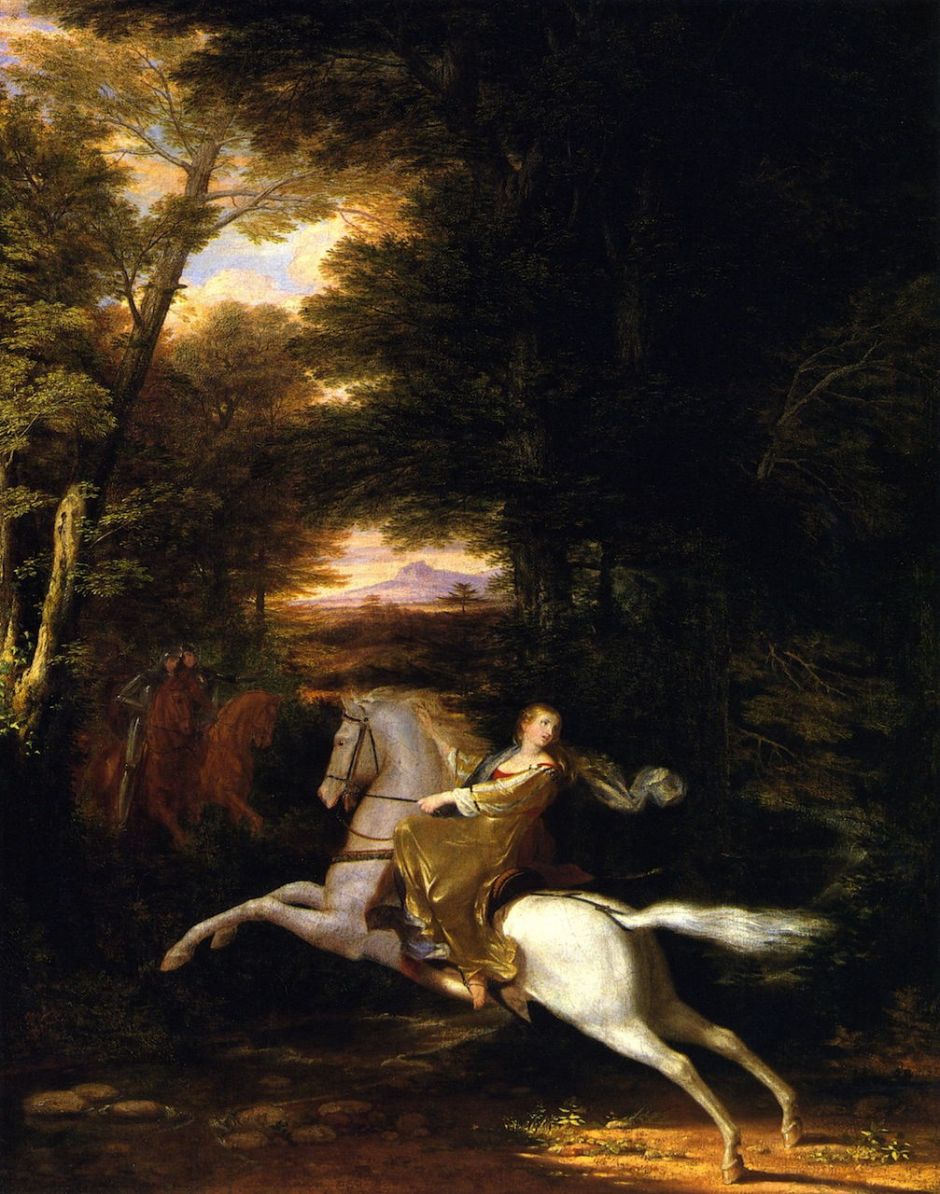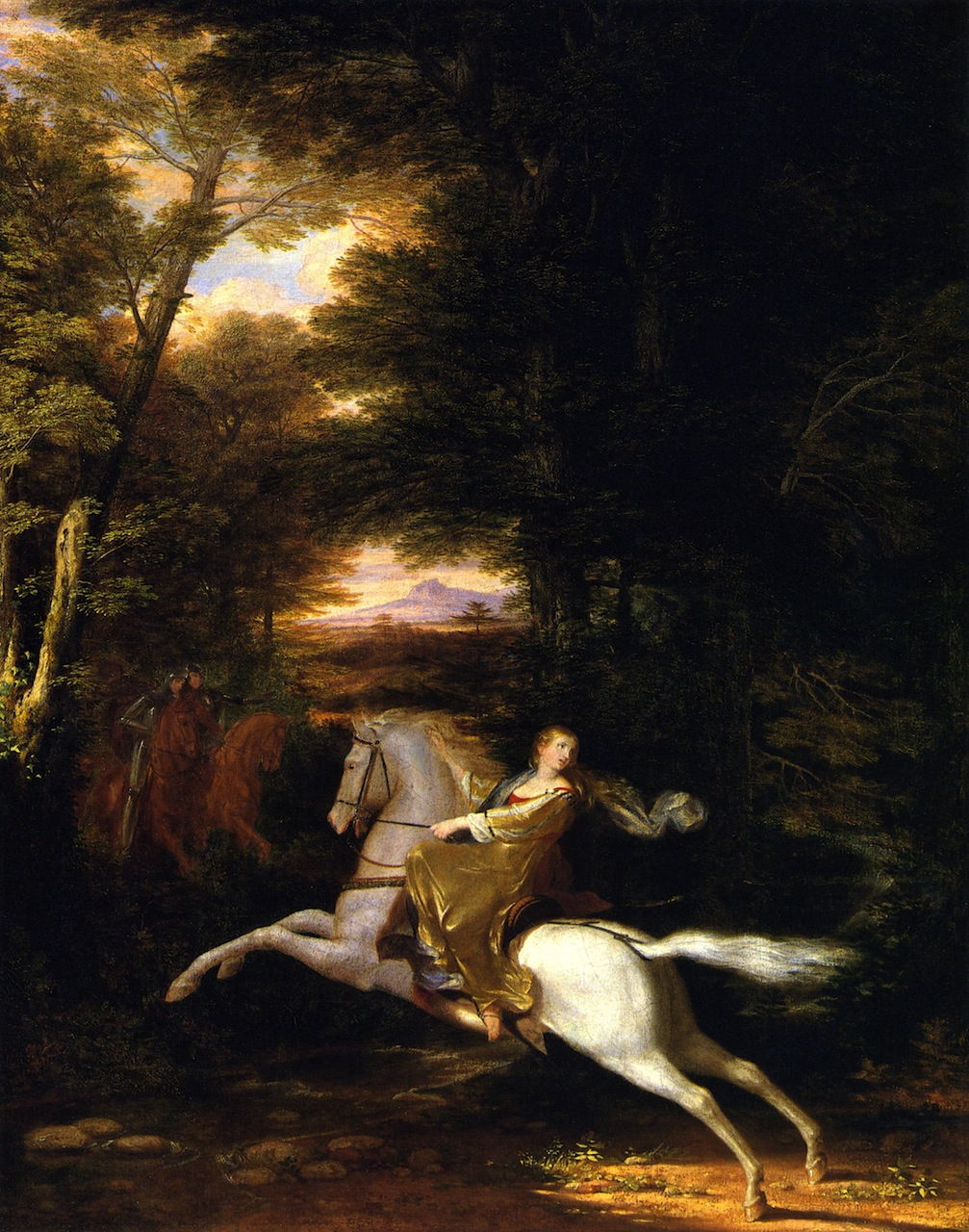In the previous episode, Britomart met the Redcrosse Knight outside Castle Joyous, where the pair of them overcame six knights. They were taken inside, where Malecasta, lady of the castle, fell for Britomart, believing her to be a male knight. When Malecasta got into bed with Britomart after a long night’s feasting, Britomart and the Redcrosse knight left in a hurry. She then told him of her incurable love for Sir Artegall, who she is now seeking.
Canto 4
Bold Marinell of Britomart,
Is throwne in the Rich strond:
Faire Florimell of Arthure is
Long followed, but not fond.
After leaving the Redcrosse knight and continuing alone, Britomart reaches the coast, where she removes her helmet, sits on the rocky shore, and pauses to reflect in the huge sea of sorrow.

Her thoughts are interrupted when another knight rides up and tells her that, unless she leaves immediately, she will be killed. Britomart refuses and charges at him with her lance lowered. His lance strikes her hard, but her lance runs straight through his shield, armour and body, leaving him dying in a pool of his own blood.

Britomart rides on and notices that all around her is sparkling with gemstones and gold. Behind her lies the moribund Marinell, whose mother is Cymoent, a Nereid, and had been warned to keep him away from women, as it was prophesied that one day a maiden would cause him great injury and grief. Marinell’s mother quickly hears of her son’s mortal wound, and, with other Nereids, sweeps his body away into the depths of the sea, where they call on the sea god Tryphon to save him.


Meanwhile, Prince Arthur and Sir Guyon have been pursuing the maiden Florimell, who is still being chased by an uncouth forester. When they reach a crossroads, the forester spots the knights pursuing him and chooses a different road, along which he is pursued by Timias, Arthur’s squire. The prince, though, continues to ride after Florimell, who is now as terrified of him as she is of the forester; the pair continue riding at speed until dark.

Canto 5
Prince Arthur heares of Florimell:
three fosters Timias wound,
Belphebe findes him almost dead,
and reareth out of sownd.
The following morning, Arthur resumes his search for the maiden, and meets a terrified dwarf, who turns out to be Florimell’s servant. The dwarf explains that his mistress had left the Faery Queene’s court in quest of Marinell, who is the only man that his mistress has ever loved, although Marinell doesn’t know of her affection for him. The prince and dwarf join forces and continue the search.
Elsewhere, Timias is looking for the forester, who has sought the aid of his two brothers. The three are now lying in wait near a ford in the river. When Timias reaches that, the forester leaps out and hurls a javelin at him, piercing his armour without injuring any underlying flesh. When Timias tries to fight the forester, the latter fends him off with a boar-spear, and one of his brothers lands an arrow in the squire’s thigh. As Timias fights his way to the top of the bank, the other brother attacks, so Timias kills him with his lance. He then swings his sword at the two remaining brothers, cleaving the head of one and beheading the other, sending the headless body into the river.

At that stage, Timias falls unconscious from loss of blood from his own wound. Almost immediately, Belphoebe the huntress arrives, staunches his bleeding with healing herbs and, with the help of her friends, takes him back to her home in a remote valley. There she cares for him, helping him recover, and he falls in love with her, but cannot declare his love. As his wound recovers, she grows baffled that he seems unable to regain his strength, as a result of his secret love.
Canto 6
The birth of fayre Belphoebe and
Of Amorett is told.
The Gardins of Adonis fraught
With pleasures manifold.
Belphoebe’s mother is Chrysogone, who was a Faery virgin. One day, she stopped to bathe in a secret pool in the forest, afterwards falling asleep naked in the sunshine. While she was asleep, the sunlight impregnated her. When Chrysogone realised she was pregnant, although still a virgin, she hid in the forest in shame, eventually giving birth to twin daughters.

At the time, Venus and Diana were searching for Cupid, and came across Chrysogone asleep with her newborn babies. Taking pity on her, they took the infants away with them. Diana reared as a huntress the girl she called Belphoebe, and Venus took the other to the Garden of Adonis, where she was brought up by Psyche and called Amoret. The latter became a paragon of grace and beauty, and a member of Gloriana’s court, where her love is often sought by knights. But she reserves it for another, remaining faithful and true to him alone.

Principal Characters
Amoret, or Amoretta, twin sister of Belphoebe, raised by Psyche as a paragon of grace and beauty, with only one true love.
Sir Artegall, a gallant and chivalrous knight, descended from the kings of Cornwall, stolen away by an elf when he was an infant. Britomart has fallen in love with his image.
Prince Arthur, son of Uther Pendragon, bearer of a magic shield which blinds his enemies and turns them to stone, and future king.
Belphoebe, twin sister of Amoret, who prefers hunting to being at court. Raised by Diana as a huntress, she is adept with her spear, and bow and arrows.
Britomart, or Britomartis, heroine of Book 3, “Chastity”, of faithfulness in true love. A woman knight and virgin, taken to represent the Fairy Queene herself, she has fallen in love with the image of the knight Artegall, and is in quest of him.
Florimell, another virgin in search of her true love, but passive and defenceless. She represents perfect beauty.
Sir Guyon, hero of Book 2, “Temperance”, a knight at the Faery Queen’s court, who stopped the wrongs of Acrasia.
Malecasta, lady of the Castle Joyous, extremely rich and quite wanton.
Marinell, a knight, son of a Nereid, who has been warned to keep away from women, as a maiden will bring him great injury and grief.
Redcrosse Knight, hero of Book 1, “Holiness”, then a knight on his first adventure; Saint George, who slays a huge dragon.
Timias, Prince Arthur’s squire, a young man who falls in love with Belphoebe.
References
Wikipedia on The Faerie Queene, with a partial summary
Wikipedia on Edmund Spenser
Richard Danson Brown (2019) The Art of the Faerie Queene, Manchester UP. ISBN 978 0 7190 8732 5. (Note: this isn’t about visual art, but literary art and poetics.)
AC Hamilton (ed) (2007) Spenser, the Faerie Queene, 2nd edn, Routledge. ISBN 978 1 4058 3281 6. (Critical edition.)
Elizabeth Heale (1999) The Faerie Queene, A Reader’s Guide, 2nd edn, Cambridge UP. ISBN 978 0 521 65468 5.
Douglas Hill (1980) Edmund Spenser, The Illustrated Faerie Queene, Newsweek Books. No ISBN.
Richard A McCabe (ed) (2010) The Oxford Handbook of Edmund Spenser, Oxford UP. ISBN 978 0 1987 0967 1.

